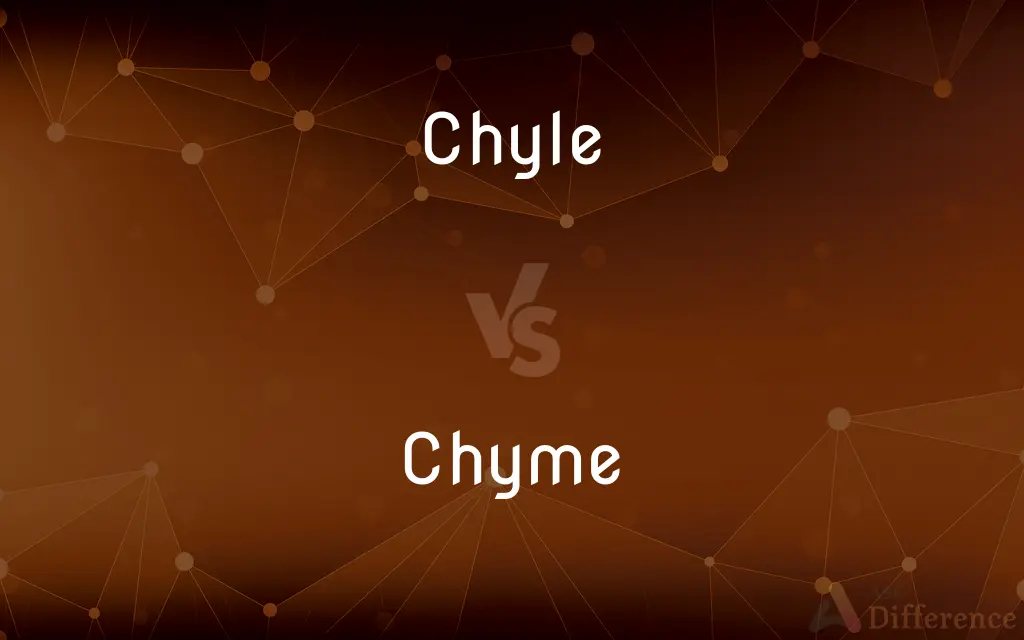Chyle vs. Chyme — What's the Difference?
Edited by Tayyaba Rehman — By Fiza Rafique — Updated on September 21, 2023
Chyle is a milky fluid consisting of lymph and emulsified fats, formed in the small intestine during digestion. Chyme is the semi-fluid mass of partly digested food that moves from the stomach to the small intestine.

Difference Between Chyle and Chyme
Table of Contents
ADVERTISEMENT
Key Differences
Chyle is a substance formed in the small intestine and is characterized by its milky appearance, which is due to the presence of emulsified fats. Chyme, on the other hand, is a semi-fluid mass created in the stomach from partly digested food and digestive juices, including stomach acid.
Chyle is involved in the absorption of fats and fat-soluble vitamins, facilitating their transport via the lymphatic system. Chyme is essential for the initial breakdown of food substances, assisted by enzymes and stomach acid, setting the stage for further digestion and absorption in the intestines.
Chyle usually forms after the chyme has moved from the stomach into the small intestine, where it mixes with bile and pancreatic juices. Thus, in the process of digestion, chyme precedes the formation of chyle. While chyme is acidic due to the stomach acids, chyle is alkaline in nature.
Though both chyle and chyme are critical for digestion, they are distinct in composition, formation, and function. Chyle plays a role in the lymphatic system, whereas chyme is more involved in the gastrointestinal system. The presence of either in abnormal locations can indicate health issues.
Comparison Chart
Composition
Lymph and emulsified fats
Partly digested food and digestive juices
ADVERTISEMENT
Formation Site
Small intestine
Stomach
PH Level
Alkaline
Acidic
System Involved
Lymphatic system
Gastrointestinal system
Function
Fat absorption and transport
Initial breakdown of food
Compare with Definitions
Chyle
A milky fluid consisting of lymph and emulsified fats.
The presence of chyle in the thoracic duct indicates digestion of fats.
Chyme
Formed in the stomach.
Stomach acid and enzymes convert food into chyme.
Chyle
Involved in the absorption of fats and fat-soluble vitamins.
Chyle plays a vital role in transporting vitamin D in the body.
Chyme
Involved in initial food breakdown.
The formation of chyme is the first major step in the digestive process.
Chyle
Transports through the lymphatic system.
Chyle moves from the intestines to the circulatory system via the lymphatic vessels.
Chyme
Essential for gastrointestinal function.
Chyme moves through the gastrointestinal tract for further digestion and absorption.
Chyle
Formed in the small intestine during digestion.
After a fatty meal, the amount of chyle in the small intestine increases.
Chyme
A semi-fluid mass of partly digested food.
Chyme is the substance that moves from the stomach to the small intestine.
Chyle
Alkaline in pH.
Unlike the acidic chyme, chyle is alkaline.
Chyme
Acidic in pH.
The acidic nature of chyme helps in the digestion of food.
Chyle
Chyle (from the Greek word χυλός chylos, "juice") is a milky bodily fluid consisting of lymph and emulsified fats, or free fatty acids (FFAs). It is formed in the small intestine during digestion of fatty foods, and taken up by lymph vessels specifically known as lacteals.
Chyme
Chyme or chymus (; from Greek χυμός khymos, "juice") is the semi-fluid mass of partly digested food that is expelled by a person's stomach, through the pyloric valve, into the duodenum (the beginning of the small intestine). Chyme results from the mechanical and chemical breakdown of a bolus and consists of partially digested food, water, hydrochloric acid, and various digestive enzymes.
Chyle
A milky fluid consisting of lymph and emulsified fat extracted from chyme by the lacteals during digestion and passed to the bloodstream through the thoracic duct.
Chyme
The thick semifluid mass of partly digested food that is passed from the stomach to the duodenum.
Chyle
A digestive fluid containing fatty droplets, found in the small intestine.
Chyme
The thick semifluid mass of partly digested food that is passed from the stomach to the duodenum.
Chyle
A milky fluid containing the fatty matter of the food in a state of emulsion, or fine mechanical division; formed from chyme by the action of the intestinal juices. It is absorbed by the lacteals, and conveyed into the blood by the thoracic duct.
Chyme
The pulpy mass of semi-digested food in the small intestines just after its passage from the stomach. It is separated in the intestines into chyle and excrement. See Chyle.
Chyle
A milky fluid consisting of lymph and emulsified fats; formed in the small intestine during digestion of ingested fats
Chyme
A semiliquid mass of partially digested food that passes from the stomach through the pyloric sphincter into the duodenum
Common Curiosities
What is chyme?
Chyme is a semi-fluid mass of partly digested food formed in the stomach.
Where is chyle formed?
Chyle is formed in the small intestine during digestion.
What is chyle?
Chyle is a milky fluid formed in the small intestine consisting of lymph and emulsified fats.
Where is chyme formed?
Chyme is formed in the stomach.
Is chyle acidic or alkaline?
Chyle is alkaline in pH.
What is the function of chyle?
Chyle is involved in the absorption of fats and fat-soluble vitamins.
Is chyme acidic or alkaline?
Chyme is acidic in pH.
What system is chyme involved in?
Chyme is part of the gastrointestinal system.
What is the function of chyme?
Chyme is essential for the initial breakdown of food.
What system is chyle involved in?
Chyle is part of the lymphatic system.
Can abnormal chyme indicate health issues?
Yes, abnormal chyme can be a sign of digestive disorders like gastroparesis.
Is chyle visible to the naked eye?
Chyle has a milky appearance and can be visible.
Can abnormal chyle indicate health issues?
Yes, abnormal chyle can be a sign of malabsorption or lymphatic disorders.
What's the primary difference between chyle and chyme?
The primary difference is in their composition and function: chyle is for fat absorption, formed in the small intestine, while chyme is for initial food breakdown, formed in the stomach.
Is chyme visible to the naked eye?
Chyme is semi-fluid and could be visible during medical procedures.
Share Your Discovery

Previous Comparison
Domineering vs. Dominate
Next Comparison
Perception vs. IntuitionAuthor Spotlight
Written by
Fiza RafiqueFiza Rafique is a skilled content writer at AskDifference.com, where she meticulously refines and enhances written pieces. Drawing from her vast editorial expertise, Fiza ensures clarity, accuracy, and precision in every article. Passionate about language, she continually seeks to elevate the quality of content for readers worldwide.
Edited by
Tayyaba RehmanTayyaba Rehman is a distinguished writer, currently serving as a primary contributor to askdifference.com. As a researcher in semantics and etymology, Tayyaba's passion for the complexity of languages and their distinctions has found a perfect home on the platform. Tayyaba delves into the intricacies of language, distinguishing between commonly confused words and phrases, thereby providing clarity for readers worldwide.















































